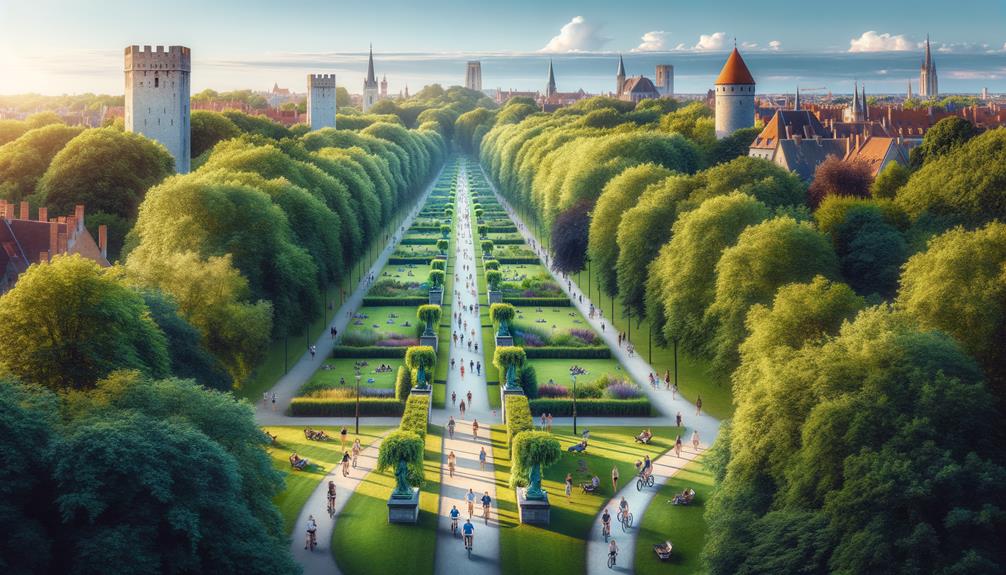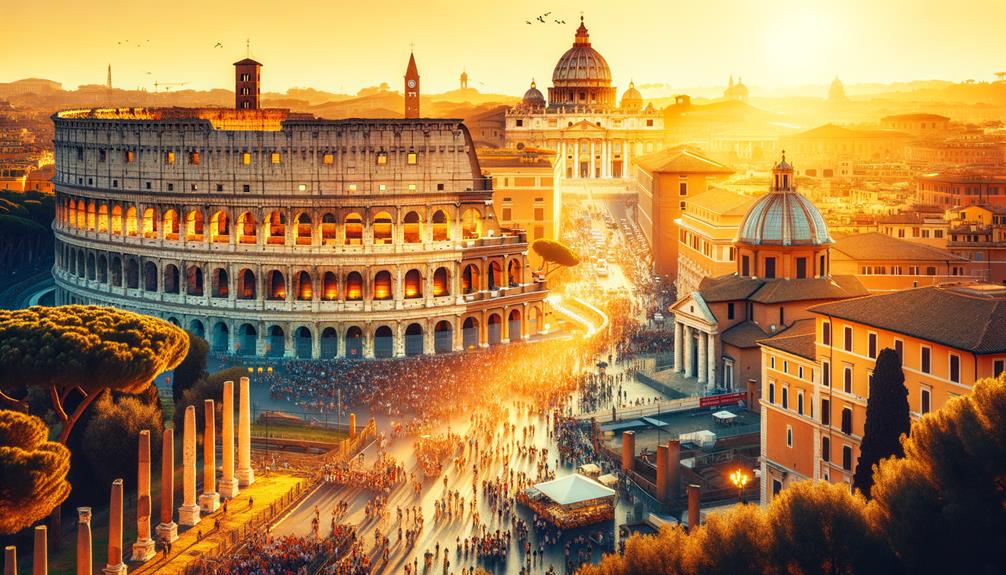I've always been curious if walking along Lucca's historic walls really feels like stepping back in time. As I strolled along the tree-lined promenade, history seemed to wrap around me. The ancient stones underfoot, carefully restored, told stories of a city that has stood the test of time. Each bastion offers a unique view, highlighting the town's beautiful architecture and the distant mountains. It's more than just a walk; it's a journey through a place where the past and present meet. But there's something even more fascinating about these walls that I learned.
History of Lucca's Walls
The history of Lucca's walls stretches back to ancient Roman times, showcasing centuries of architectural evolution and military strategy. Walking along the Mura di Lucca, I felt a deep connection to the past. Originally built as Roman fortifications, these walls have seen countless changes over the centuries.
The medieval period added more layers of defense and splendor to the walls. By the nineteenth century, under the direction of Duchess Maria Luisa, the walls were carefully restored and preserved, keeping them completely intact. This means that today, we can walk atop these ancient structures, experiencing the weight of history beneath our feet.
Standing at Porta San Donato, I admired the gates that once protected the city's entrances. The nearby Cathedral of San Martino adds to the historic atmosphere, its ancient stones telling stories of a bygone era. Walking around the perimeter, I appreciated the mix of open space and the sense of security these walls once provided. Every step on the Mura di Lucca felt like a journey through time, offering a glimpse into the city's resilient spirit and architectural brilliance.
Exploring the Bastions
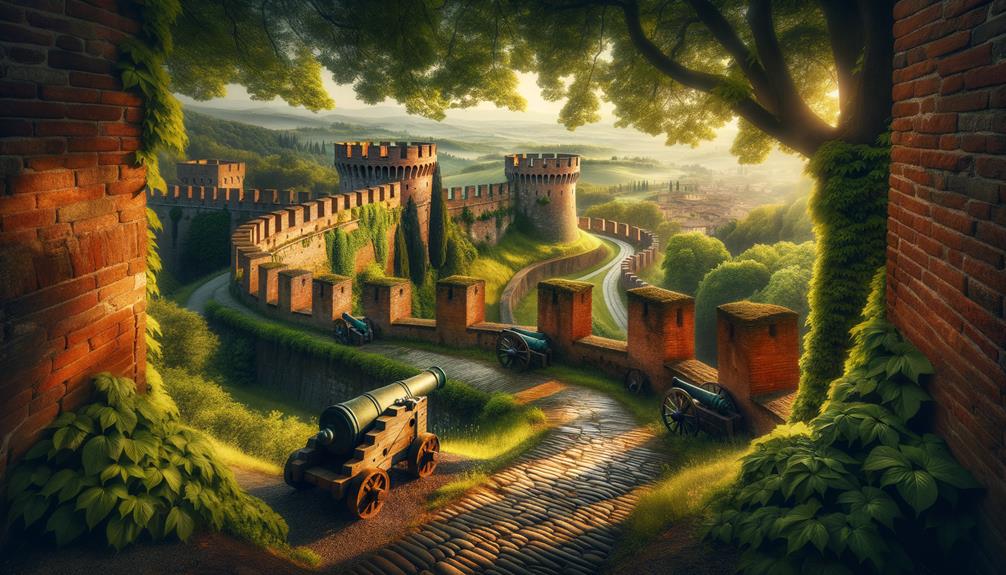
Walking along the bastions, I was struck by their impressive structure and the sweeping views of Lucca's picturesque landscape. The ancient city walls, known as Mura, wrap around the town like a protective shield. Each step along these walls reveals a new aspect of Lucca, from its lively squares to its peaceful gardens.
Baluardo Santa Maria stands out as the most impressive bastion, offering stunning views of the city. It's a place where history and nature blend, creating a peaceful space for contemplation. With every step, I felt a sense of freedom, heightened by the open sky and the gentle breeze.
| Bastion | Highlights |
|---|---|
| Baluardo Santa Maria | Panoramic city views |
| Baluardo San Paolino | Historic cannons |
| Baluardo San Martino | Secluded green spaces |
The walls themselves symbolize Lucca's resilience and creativity. Each bastion has a unique character, adding to the overall grandeur of the Mura. Whether I was admiring the distant mountains or taking in the intricate details of the old city, walking the walls felt like a journey through time while still being in the present. The bastions are not just structures; they tell the rich and vibrant history of Lucca.
Activities on the Walls
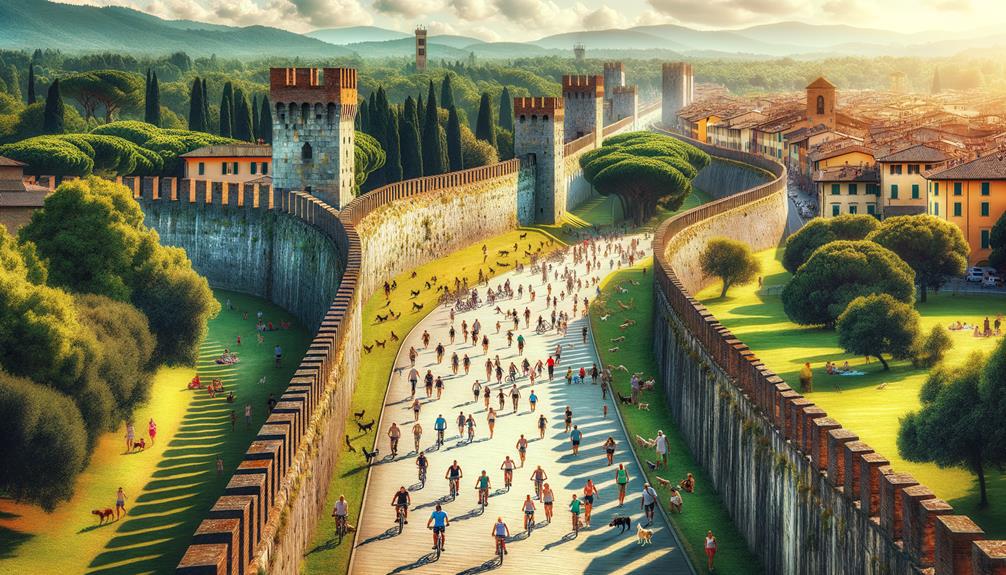
Walking along the historic walls of Lucca, I couldn't help but notice how they come alive with various activities that breathe life into this ancient structure. Locals and visitors alike find their own ways to enjoy this raised promenade. As I walk around, I see the walls of Lucca serving as a vibrant urban park, perfect for a leisurely stroll around the old city.
From via Santa to San, the path is lined with trees, offering a picturesque backdrop. Families with young children trundle along in rented pedalos, their laughter filling the air. Cyclists zoom past, and dog-walkers amble by, creating a dynamic yet relaxed atmosphere. There's truly something for everyone.
- Cycling: A popular choice, with smooth paths and scenic views.
- Dog-walking: Perfect for pet owners to explore Le Mura.
- Picnicking: Plenty of spots with children's play equipment.
- Cafés and Museums: Rest stops like the Museum of Money and various cafés.
As I continued, I couldn't help but be charmed by the panoramic views of the old city and the Tuscan landscape. Exploring near Palazzo Pfanner, I felt a deep connection to both the history and the present life of Lucca.
Scenic Views and Photography
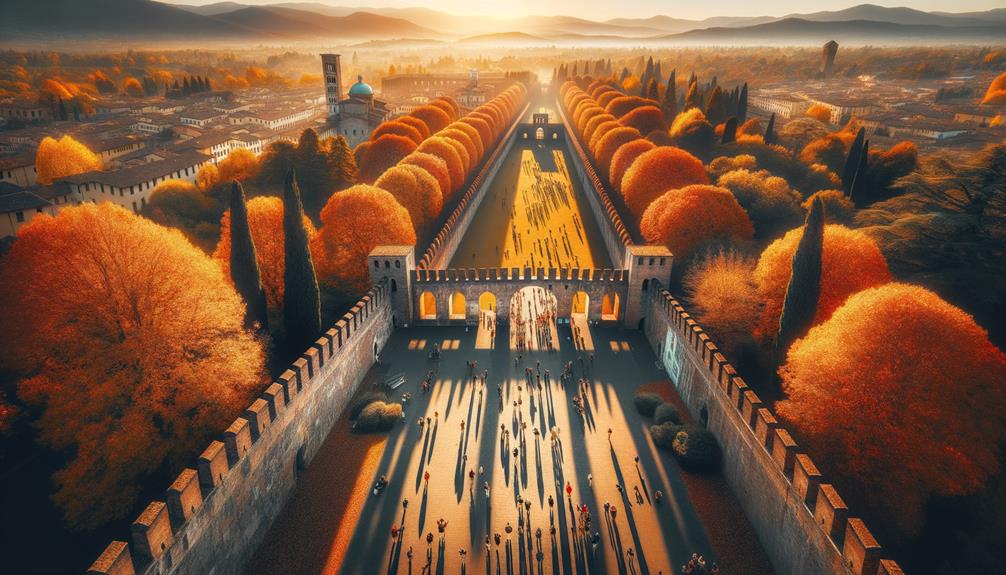
As I took in the lively activities on the walls, I couldn't help but be drawn to the stunning scenic views and endless photo opportunities they provided. The city of Lucca, wrapped in its medieval walls, unfolded before me like a timeless tapestry. From Porta Santa Maria to Porta San Pietro, the panoramic views truly captured the essence of this historic gem.
Standing near delle Mura, I was struck by the ancient stone fortifications that contrasted beautifully with the lush greenery below. Each step along the walls offered a new angle for photography, from the peaceful river flowing by to the bustling piazzas. San Frediano's striking facade, with its detailed mosaics, was especially captivating in the golden afternoon light.
To help fellow visitors snap these moments, here's a table of top photography spots:
| Location | Best Time | Key Features |
|---|---|---|
| Porta Santa Maria | Morning | Soft light, fewer people |
| Porta San Pietro | Sunset | Warm hues, dramatic shadows |
| Delle Mura | Afternoon | Green landscapes, historic walls |
| San Frediano | Late Afternoon | Illuminated mosaics, detailed shots |
| City Overviews | Anytime | Panoramic views, cityscape beauty |
Each spot offers a unique perspective, inviting you to explore and capture the beauty of Lucca's breathtaking views.
Nearby Attractions
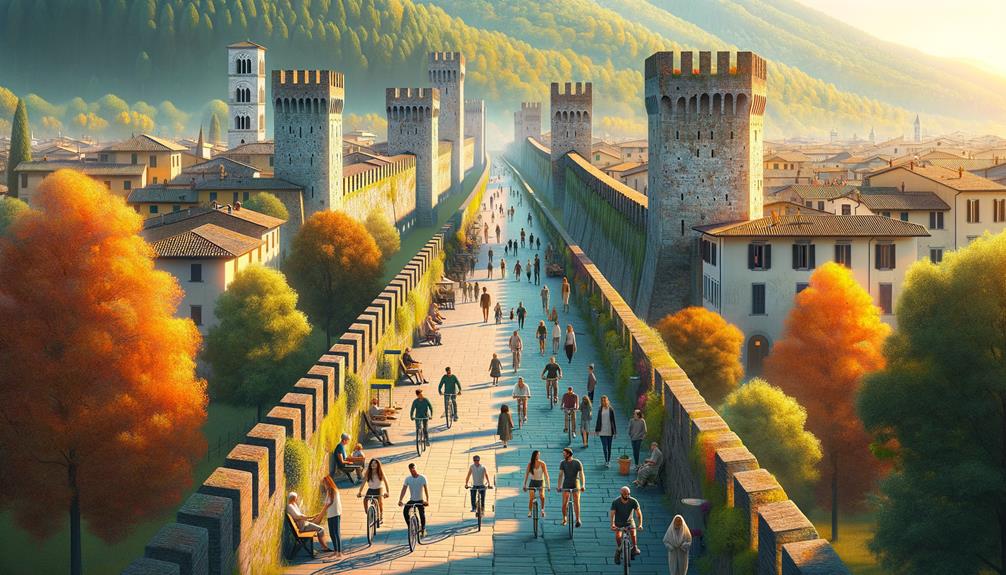
Wandering through the historic walls of Lucca, I found that the nearby attractions offer a rich mix of history, culture, and architectural beauty. As I walked around the town, I felt immersed in a blend of old and new, with each step revealing stories from centuries past.
One of my favorite spots is the Piazza Anfiteatro, built on the site of the Roman amphitheatre. The arches now house charming restaurants and shops, creating a lively, yet historical vibe. The Cathedral of Lucca, with its medieval labyrinth carving and Tintoretto's Last Supper painting, is a testament to the city's rich artistic heritage.
While strolling along the walls, I also checked out:
- Palazzo Pfanner: A stunning museum with beautiful gardens that take you back in time.
- Palazzo Mansi: Featuring luxurious rooms and impressive art collections.
- Puccini Birthplace: Celebrating the life and works of the famous composer.
- Via Francigena: Part of an ancient pilgrimage route that offers a unique walking experience.
Around Lucca, the mix of historic structures and vibrant streets made every moment an adventure. Being close to Florence and Pisa, Lucca is a must-visit gem in any Tuscan itinerary.
Frequently Asked Questions
How Long Does It Take to Walk Around the Wall in Lucca?
Time seems to move at a different pace when you're surrounded by history. Strolling around the wall in Lucca takes about 56 minutes. It's a peaceful walk, ideal for those looking to enjoy some quiet time with plenty of shaded benches and gentle slopes.
How to Access Lucca Walls?
I got into the Lucca walls through one of the four main gates: Porta San Pietro, Porta Santa Maria, Porta San Donato, or Porta Elisa. Each gate had its own unique charm and entryway into the historic town.
How Long Does It Take to Cycle Around the Walls of Lucca?
Riding a bike around Lucca's walls takes about 20-30 minutes at a steady pace. It's a fun ride, though you might need to slow down for crossings and walkers. It's a great mix of history and freedom.
Is One Day in Lucca Enough?
Is one day enough to soak in the charm of Lucca? I wandered through its narrow streets, took in the ancient architecture, and savored the local cuisine. While a single day gives you a taste, spending more time there would really allow Lucca's beauty to shine.

